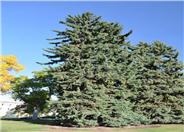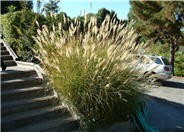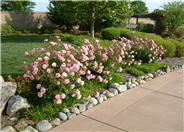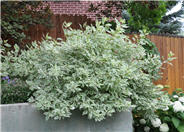
Common name:Norway Spruce
Botanical name:Picea abies
Norway spruce is a large evergreen tree, growing 40 to 60 feet tall and 25 to 30 feet wide, with horizontal branches and pendulus branchlets, giving it a graceful appearance. It is fairly dense when young, but opens up with age. Needles are stiff, 0.5 to 1 inch long, tending to point downwards and towards the stem tip, and are medium green. Cones form at the ends of branches, are 4 to 6 inches long, and are light green maturing to brown. Bark is grey-brown and peels. There are dozens and dozens of cultivars available.

Common name:Yaku Jima Maidengrass
Botanical name:Miscanthus sinensis 'Yaku Jima'
This medium-sized Miscanthus grows to about 3 to 4 feet tall and wide, with plumes raising another 1 to 2 feet above the leaves. Yaku Jima has fine-textured, green foliage that turns reddish brown with a hard frost. The plumes emerge mid-September, reddish in color, eventually turning nearly white.

Common name:Floribunda Rose
Botanical name:Rosa floribunda
This group of roses is characterized by short stems topped with clusters of small flowers. They tend to have a rounded, mounded form, generally as tall as they are wide. They have thick, leathery leaves, sometimes producing lovely fall color, but also helping to grow vigorous, sturdy shrubs. Flowers are in the typical rose colors (though maybe less of the kaleidoscope that are the hybrid teas), from single-petaled to cabbage, and maybe with fabulous fragrance. Some bloom once, but most bloom off and on all summer. Most produce great hips, quite suitable for harvesting, though leave some for the song birds.

Common name:Ivory Halo Dogwood
Botanical name:Cornus alba 'Bailhalo'
Ivory Halo is a smaller version of variegated dogwood, growing about 5 to 6 feet tall and wide, wide a compact rounded habit. Leaves are light green and white, and red in the fall. Bark is red and provides wonderful winter interest, especially when planted infront of evergreens or solid fences. It produces white flowers in late spring, which are followed by blue-white berries. Use in the shrub or foundation border, and combines effectively cotoneaster, hydrangea, spirea, viburnum, and wiegala.
| Designer: | Green Corner 22 |
Photographer: GardenSoft |
Water Saving Tip:
Apply a layer of mulch around plants to reduce moisture loss.
Choose organic mulches, such as shredded bark, compost or aged sawdust.
